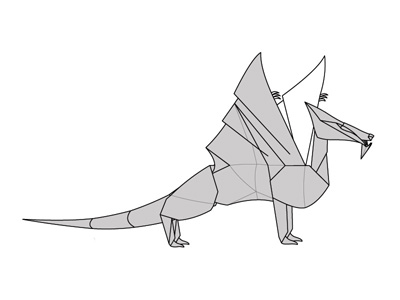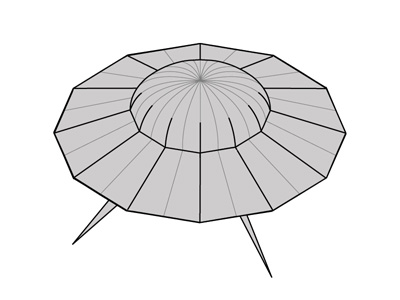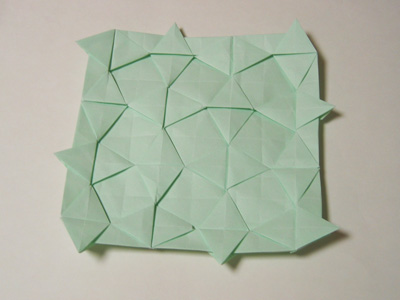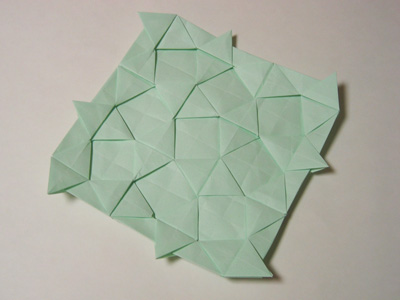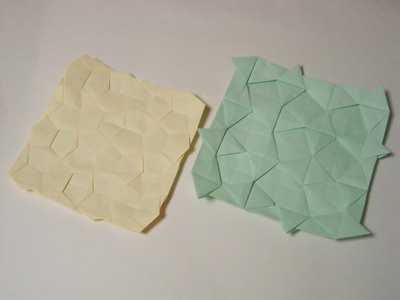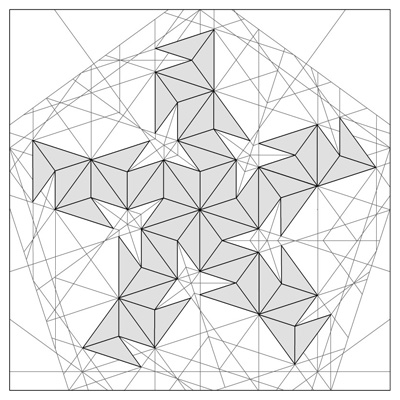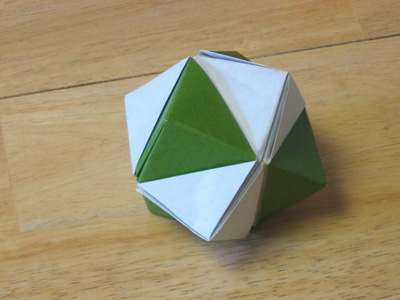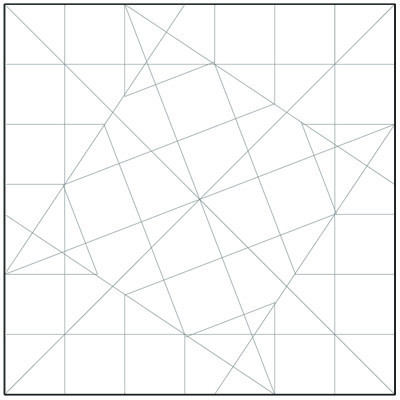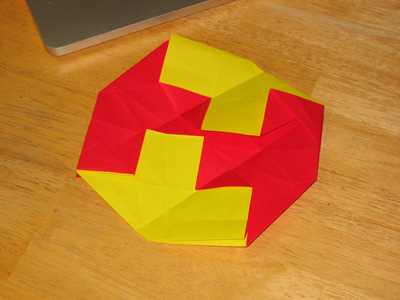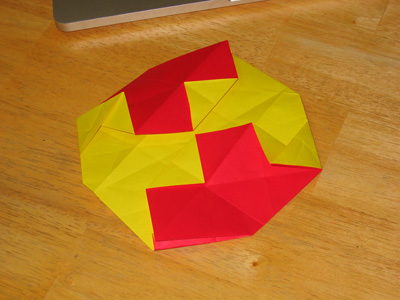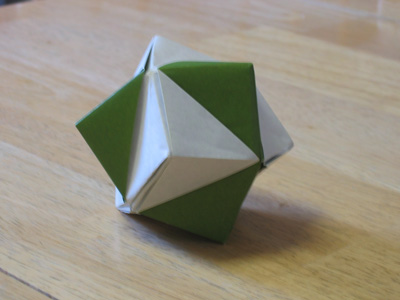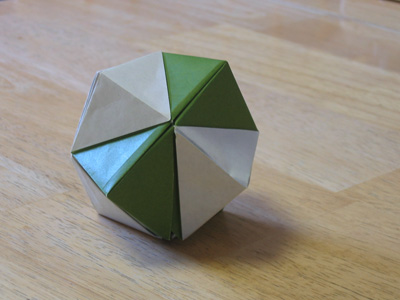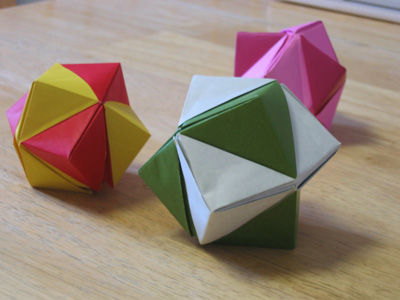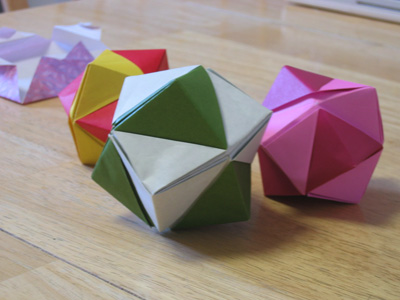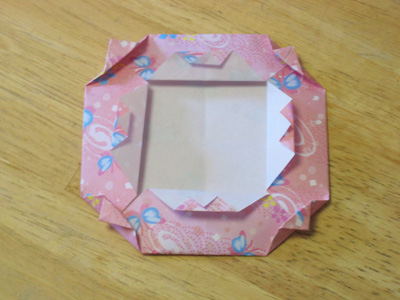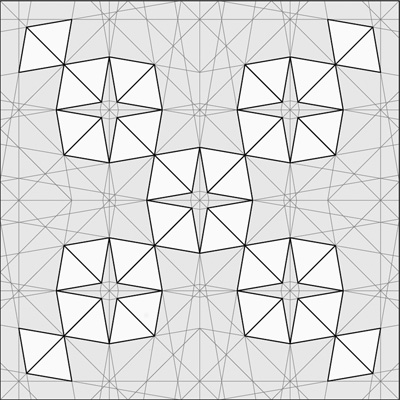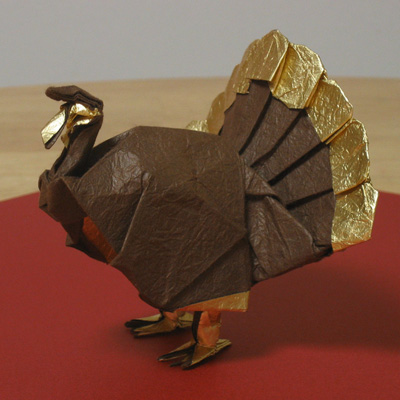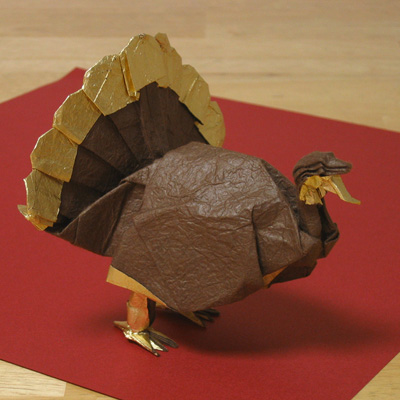If you’re not an origami person you’ll probably look at this and think “what a bunch of geeks”. But I know these people and find it pretty amusing. Jason Ku, Andrew Hudson, Robert Lang and Daniel Myer perform at the 5OSME (5th International Conference for Origami Science, Mathematics and Education) banquet in Singapore earlier this month.
Category: Origami
OUSA Convention 2010
It’s been a busy couple of weeks. First there was the origami convention and then we took a road trip upstate for the 4th to see family and friends. Now we’re back and catching up on things. We’re experiencing a major heat wave. It got up to 100 degrees today in New York City. Tomorrow’s gonna get up to a hundred and one.
It was a most excellent origami convention this year. I had six new models in my exhibit, including my Zeppelin, Turkey, Two-Color Stellated Octahedron, Great Dodecahedron, the Cairo Tessellation and its dual, which I’m calling the Cubocta Tessellation because its pattern of alternating squares and triangles reminds me of the Cuboctahedron. Classic models displayed included my Moose, Elephant, Lizard, Turtle, Rocketship and U.F.O. I’ll have pictures of mine and the other exhibits sometime soon.
I taught two classes: My U.F.O. and my Medieval Dragon. Both were well attended and went over well. The U.F.O. is a pretty advanced model and I warned them ahead of time. About a third of the class worked ahead, following my diagrams and had no problems. Most of the rest were right with me as I taught it, and there were a few who were in over their heads and couldn’t handle the precision necessary for the prefolding. The Dragon was sold out, which made it hard to teach cuz the room was big and I had to walk around a lot to show people steps close up. Again about half folded ahead and about half were with me, and I learned that a few steps in the diagrams were hard to follow. It turns out the Dragon is a great model for sculpting and I saw people do lots of cool creative interpretation with the details of the head, wings and tail.
Lizzy and Michelle were there two and folded a bunch of stuff and had a great time. They’re getting to be pretty good folders. They made friends with some other kids and stayed late Sunday for the giant folding competition. Michelle was really proud to have an Exhibitor ribbon on her badge, since she had a model in the Origami by Children exhibit.
I caught up with a bunch of my origami friends including John, Brian, Susan and Brian, and made some new friends too. John is selling iPhone and Android versions of his books now. Apparently it’s a lot of fun and at least moderately remunerative for him. He’s also coming out with four new print books this year, including new editions of the classics Dinosaur Origami and Origami Sea Life with Robert Lang, with updated diagrams and a bunch of new models. While he was in NYC John met with his publisher and they gave him back a box of models that they’d used for photos of the book cover. Some of them were Robert’s sea creatures, so John kept surreptitiously putting one or two of them on Robert’s exhibit over the course of the weekend.
Susan Thomas in addition to origami does this thing with making jewelry out of rings of chain mail and rubber o-rings. It’s a pretty cool idea and she has a book out on it, and it seems to be catching on. Jeannie made a bracelet, and Susan gave a bracelet to Lizzy and Michelle, and they’ve all been getting lots of compliments on them. I think it’d be pretty wild to make a sweater or something using that technique.
I met Roman Diaz from Uruguay, who is a very nice guy and brilliant origami artist. I want to get his new book, Origami Essence, but they were sold out of it at the convention. I gave him one of my models, a half Stellated Dodecahedron. I met Alexis from Quebec who is an excellent folder too. I met Alexis because he took my U.F.O class and suggested an improvement to a sequence of folds. We got to talking, and I invited him to be my partner for the giant folding competition.
The giant folding was a new thing last year and it turned out to be really popular, so this year there were a lot more participants. I folded my Lizard out of a nine foot square. I figured it was a good model because the paper is so big and heavy a lot of models turn out floppy, but the Lizard lies on it’s belly and has enough layers that it’d keep its shape. I taught Alexis the model the day before and he seemed to have basically memorized it, so we had no problem folding it in the allotted hour. And it turned out looking really cool, like an ice blue Komodo Dragon. And we even won the prize for coolest model. A lot of other teams made really nice models too. Some standouts were Roman’s frog and Aviv’s Kawasaki Rose. Lizzy folded a snake. We’re gonna burn ours when we go camping later this month.
The most interesting class I took on Monday was by Nathan Zeichner, who is a CS student developing his own origami software. It has an interesting spin in that it’s part of a project to create self-folding origami robots, if you can believe that. I talked to him a length after his lecture. He said he was inspired by my paper in 3OSME.
Since lots of people were asking about it, I have to say I feel good about how my book is shaping up. I have over 100 pages diagrammed now. I’ve organized into chapters and have a few more models to design and diagram to round things out. I’ve decided to jettison my polyhedra for a future book since I have enough material already and they will be really hard to diagram. So that suddenly puts me alot closer to completion. It also puts the center of gravity in the intermediate to complex range rather then the supercomplex, which I think will have a broader appeal.
Next up: road trippin’. Coming soon OUSA Convention pictures.
Back to the Beach
It really feels like summer now. It’s been a really hot week, up in the 90’s every day. Last Sunday was Father’s day and we spent a great day out at the beach swimming in the ocean. Earlier this week was the summer solstice. Yesterday was the kid’s last day of school, and both kids made the honor roll and now they’re on summer vacation. Now I have Ocean City on my mind, but there’s lots of adventures to get thru first.
It looks like one of the elm trees in our yard is sick. Maybe Dutch Elm disease. That’d be a bummer cuz we may have to cut it down to save the other one. At least it’s the lesser of the two elms, not the champion elm that I’ve grown particularly fond of is home to the family of squirrels that includes the red one with the black tail. The sick one is almost as huge and extends to over to our neighbor diagonally across the street. It’s very lopsided and I figured its destiny would be to fall over in a storm and take out 4 houses worth of power lines.
My office remains chaotic, although I’ve been productive and zen about the situation as things swirl around me. Viacom lost their big billion dollar lawsuit against Google – thrown out of court — so it’ll be interesting to see if there’s any fallout from that. My boss is in a bit of a funk over her deceased cat. I’m taking some time off over the next two weeks. A much needed break.
My recording project has progressed to the actual mastering, and Blick wired up a chain of external gear including a Weiss EQ and something called a BCL (Bass enhancer, Compressor, and Limiter). We rendered out the mixes without the final master effects (mainly dynamic compression) and ran them thru this chain instead. The difference was really striking. I’m really psyched. Blick is really getting into it. It seems he doesn’t get the chance to master full albums very much (mostly does promos and soundtracks fror TV shows) so he’s putting his full effort into it. His partner Glen dropped by and liked the sound. He dug Green Glove, saying it sounded just like Night Fly. Which I’m taking as a compliment, since it’s the most deliberately Steely track on the record.
After many attempts I successfully folded an origami zeppelin tonight. So I have one more nice new model for my exhibit this year. It also is the last word on the series of polar coordinate flying things that include my Rocketship, Hot Air Balloon and U.F.O.
Origami Book Progress
It’s been a long time since I bogged about my ongoing origami book. Well I recently finished diagramming two more models. One is my Medieval Dragon, clocking an just about 100 steps. That’s twelve pages as I currently have it laid out. The other is my U.F.O., which is ten pages and a shade above 60 steps, but from step 40 or so onward it’s all fully three dimensional, so each step is a major work of drawing. These are by far two most involved models I’ve done so far. The only thing that comes close is my Adirondack Moose, which is also about 60 steps, but it’s only 3-d for the last few steps. Both the Moose and the Dragon are fairly traditional designs, using variations on classic bases and inspired by models in John Montroll’s first book. The U.F.O. however is completely modern and without an antecedent, and well over half the folding sequence is precreasing. So while it may not seem like a lot in terms of number of models, it’s a lot in terms of page count, and I knocked of two major models to boot. This brings me up to 16 models done, about 90 pages worth. I’m definitely more than halfway done with the book, so I think its time to start looking at the publishing process.
I signed up to teach both of these at the upcoming OUSA convention – only a week away. So I’m glad I got the diagrams finished but as usual I have lots of ideas for things I’d like to fold but haven’t had the time to fully develop. So I think this weekend will be a big folding jam.
I’m posting pics of the final step of each model as a way to motivate myself to continue by showing the result without giving away the whole diagram. I may go back and post pictures of the final steps of my other completed diagrams to create a sort of evolving table of contents. I need to update my origami site anyway. I have a number of models, going back more than a year, that I need to photograph and post. Well July will be a good time for that. I always get a big boots of energy and creativity from the convention, and that will fuel me into the summer to continue developing things.
Tri-Square Origami Tessellation
My first origami tessellations was a grid of pentagons. Now I’ve made a tessellation of triangles and squares to go with it. And mean that in a very specific way. This mesh is the dual of the other. If you draw a dot in the center of each cell of the pentagon grid and connect them all, you’d get this pattern. Five cells converge at each vertex. In the other pattern all the cells were the same shape, but either three or four cells converged at a vertex. I’ve never seen anyone fold this pattern before and the two of them make a nice set.
Spring Outing With Origami
We had another fantastic spring weekend. The weather has been great but that means we’re having an early allergy season this year. My hay fever has been going on for a couple of weeks and is peaking right about now, so I can expect them to diminish soon. Compared to other years it’s not that bad. I never had pollen allergies until they year 2000, but then last year they were a lot less severe and this year the same. Weird.
Saturday we helped Lizzy with her project for her school’s science fair. She was wondering if heavier things fall faster than light things (like a rock compared to a feather) and designed an experiment to test her hypothesis. She and a classmate filled out several water bottles with different materials: sand, water, cotton balls and empty (air), and dropped them out of a window two at a time, and observed which landed first for numerous trials, basically recapitulating Galileo’s classic experiment. To her surprise, they all pretty much fell at the same speed, except the empty one, which seemed to be slowed down a bit by the air. This got us into a whole discussion of weight vs. air resistance and shape, and turned out to be quite a good experience for her. She’s already thinking of ideas for her next year’s project. I’m trying to convince her to build a Tesla coil.
Sunday was an origami Special Sessions event at the Museum of Natural History in the city, and I volunteered to teach a class. We made the day into a family outing with the kids. Took a walk thru Central Park to Strawberry Fields (Michelle’s request in keeping with her current Beatles obsession) and to the Belvedere weather station. In the museum Lizzy asked to see the hall of minerals, which was a very cool thing to see, and something we usually overlook when we’re there.
The model I taught was my Turkey, which I developed over the winter. I have not diagrammed it yet and it had been a few months since I folded it, so I was a bit concerned if I needed to be more prepared. It took me a couple of minutes to remember the first few folds that set up the geometry for the whole model, but once I got that we were off and running. The folding sequence for the feet is pretty complicated, but I remembered that as I went and it worked out fine. The tail and head were a bit tricky. I never really worked out a single best folding sequence for either; it’s always a bit improvisational. The class turned out to be a success, but I feel like I should drill down on these details and nail down the best way to do the sculpting. This will be necessary when I get around to diagramming it anyway.
Meanwhile the girls took a class to fold flowers out of ribbons. After the class we headed back into the museum and checked out the marine hall under the life sized whale replica.
Today I used my new library card for the first time. The real library (where all the books are) is across the street from the main library. I have a long list of books I want to read, but I soon discovered the card catalog system there is kind of a mess. It’s all computerized and the listing mixes books from the two buildings. So in the end I just walked over to the fiction section and borrowed a bunch of books from authors whose names are in the S – Z range. Mostly 100 year old science fiction: Shelly, Stoker, Jules Verne and H. G. Wells, with some Steinbeck and Terry Southern thrown in for good measure. I told Jeannie I borrowed seven books and she said “You’re just like Lizzy. Make sure you remember the due date.” Heh.
Origami Great Dodecahedron
Here is a crease pattern for an origami Great Dodecahedron. This fascinating shape is something like a sunken icosahedron, and can also be seen as twelve intersecting pentagons with a raised star on each face. I tried several iterations of the layout because the details of forming tabs and pockets to close the model took some trial and error to get right. The basic idea is fairly straightforward. I use fivefold polar symmetry, and the whole pattern embedded in a single pentagon that takes up pretty much the entire square sheet. I was able to divide it into a grid of parallelograms using simple ratios. Each parallelogram then gets subdivided into the triangles that form the faces of the shape.
Since I just fold back the corners of the square to form the base pentagon, I tried a version folded from a pentagonal sheet, but this turned out not have enough extra paper around the edges to from the tabs and pockets. The pentagon’s height is slightly less than its width, which results in a then strip of unused paper at the bottom edge of a square sheet. I decided to try folding the strip around all five sides (except where it gets truncated at the corners), and that turned out be just the trick.
I’ve successfully folded a couple of these now that stay together well. Pictures as soon as I make one out of nice paper.
Dual Color Stellated Octahedron
Here’s an idea I’ve been working on for a while. I’ve seen this kind of thing done as modular and thought it was doable as a single sheet, and I figured I’d go for it. Single-sheet stellated polyhedra are pretty advanced, but the color change brings it to a whole ‘nuther level of complexity. It turns out to be a very rewarding shape to fold, and the design is replete with all kinds of interesting symmetries.
The first challenge was to work out how to achieve the arrangement of alternating colors. Once I’d worked that out the resulting (flat) shape would serve as the base for the 3-d phase. I needed two corners to come to the center like a blintz, but offset. Working out the amount of offset for the grid to be the right size was the key problem. It turns out the key angle is 67.5 degrees, which is 3/4 of 90 degrees and easily derived. It also turns out the angle has a slope of 3/2, which is also easily derived from a square grid. From this I was able to work out the arrangement of the squares in the inner rotated grid and the outer triangular grid areas, which correspond to the blintzed flaps. The 3/2 slope made was convenient because the grid is has an integer relation of the unit the whole. Each square of the grid has a length of 2/13 the edge of the paper, as you can see in the crease pattern. Neat, huh?
Another interesting property of the model is that once you’ve made the base and put in the color change squares, the easiest way to deal with the leftover paper on the two remaining corners is to flip the model over and do the same thing. The result is the pattern is the same on both sides, although made with opposite colors, and either side can be used for the outside.
The finished model fold together well and looks really good. I went ahead and made a few.
As an added bonus Lizzy and Michelle were folding bowls and picture frames, so here’s one.
Getting Back Into Shapes
It’s been a rough week. I had a bit of a pain in my leg which turned out be caused by a swollen or pinched nerve. I tend to have a few aches in my legs this time of year due to the cold, but this got bad enough I needed to go see a doctor. Maybe it was a blessing in disguise, since I’ve been feeling down about my work situation lately and I had a few days off, a break from that unpleasantness and drama and from commuting in the cold, and I took a few days to rest and reset. Now that I’m on the mend physically, I’m much less burned out mentally too.
I got a chance to work on some more origami ideas this week. I have a handful of polyhedra I’ve been trying to perfect for a while now. One of them is the Stellated Rhombic Dodecahedron, and I had a half-fold one I started ages ago and I thought I’d finish it off. But as I got into, I realized the layout was kind of weird and I could do better. So here is the new improved layout. As you can see, the layout is nice and symmetrical, and that makes the precreasing relatively straightforward. The forty-right triangles that make up the faces are based on the geometry of the silver ratio. There is a border that runs the whole way ‘round the paper to provide flaps at the corners to tuck in and finish the model. As luck would have it, I picked a good size for the flap to provide a reference to set up the silver ratio without having to find any other landmarks. I’ve folded a couple of these now, working out a clean way to close the model. Look for completed model in the near future.
Cold Turkey
Now that some things with the weather, work and the recording project have been sorted out, it’s time to get back to origami. My turkey has been sitting half-folded on my desk fro weeks and I finally had the chance to finish it off. Good thing too, I’m teaching it this spring, and need to get all the details worked out.
